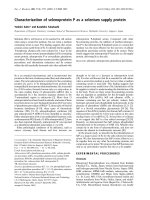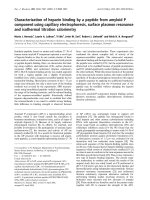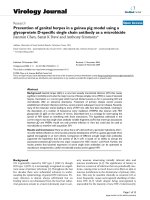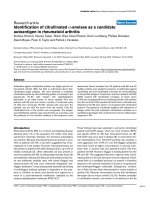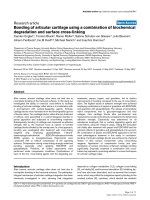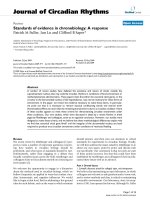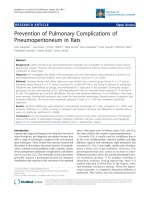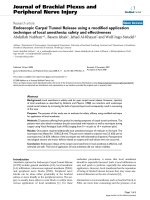Báo cáo y học: "Prevention of Pleural Adhesions Using a Membrane Containing Polyethylene Glycol "
Bạn đang xem bản rút gọn của tài liệu. Xem và tải ngay bản đầy đủ của tài liệu tại đây (526.51 KB, 7 trang )
Int. J. Med. Sci. 2011, 8
380
I
I
n
n
t
t
e
e
r
r
n
n
a
a
t
t
i
i
o
o
n
n
a
a
l
l
J
J
o
o
u
u
r
r
n
n
a
a
l
l
o
o
f
f
M
M
e
e
d
d
i
i
c
c
a
a
l
l
S
S
c
c
i
i
e
e
n
n
c
c
e
e
s
s
2011; 8(5):380-386
Research Paper
Prevention of Pleural Adhesions Using a Membrane Containing Polyeth-
ylene Glycol in Rats
Volkan Karacam
1
, Ahmet Onen
2
, Aydin Sanli
2
, Duygu Gurel
3
, Aydanur Kargi
3
, Sami Karapolat
4
, Nezih
Ozdemir
2
1. Department of Thoracic Surgery, State Hospital, Bilecik, Turkey
2. Department of Thoracic Surgery, Dokuz Eylul University, Izmir, Turkey
3. Department of Pathology, Dokuz Eylul University, Izmir, Turkey
4. Department of Thoracic Surgery, Duzce University, Duzce, Turkey
Corresponding author: Volkan Karacam MD., Department of Thoracic Surgery, State Hospital, Bilecik, Turkey. Phone:
+90 (228) 212 10 36; Fax: +90 (228) 212 57 98; E–mail:
© Ivyspring International Publisher. This is an open-access article distributed under the terms of the Creative Commons License (
licenses/by-nc-nd/3.0/). Reproduction is permitted for personal, noncommercial use, provided that the article is in whole, unmodified, and properly cited.
Received: 2011.03.28; Accepted: 2011.05.31; Published: 2011.06.17
Abstract
Background: Recurrent thoracotomies regardless of the cause are not a rare occurrence.
However, each thoracotomy results in adhesion to some extent. This adhesions increase
morbidity and mortality presents a significant inconvenience for surgeons and prolongs
the length of operations.
Objective: We investigated the efficacy of Prevadh®, an anti-adhesion agent to prevent
intrapleural adesions following thoracotomy in a rat model.
Methods: Twenty male adult Wistar Albino rats were divided into a sham group (Group
A, n = 4), a control group (Group B, n = 8), and a study group (Group C, n = 8). Only left
thoracotomy was performed in Group A. Group B underwent left thoracotomy, induc-
tion of adhesion, and 1 ml saline solution was administered to the thoracic cavity.
However, in Group C underwent left thoracotomy, induction of adhesion, and Prevadh®
was placed between the pleura and the lung. The rats were sacrificed on day 21, and
adhesions were analyzed using both macroscopic and histopathological methods. The
results were statistically analyzed. A value of P<0.05 was considered statistically
significant.
Results: Mean lengths of adhesion differed statistically significantly among all three
groups, while mean intensity of adhesion differed between Group A and Group B, and
between Group B and Group C (P>0.05). There was also a statistically significant differ-
ence between Group A and Group C in mesothelium proliferation score (P>0.05). No
statistically significant differences were found among the groups in terms of pleural
thickness, macrophage and mononuclear cell infiltration (P>0.05).
Conclusions: Prevadh® was shown in a rat model to effectively prevent
post-thoracotomy adhesions.
Key words: Thoracic Surgery; Thoracotomy; Tissue Adhesions; Polyethylene Glycols
INTRODUCTION
There are only a few studies on intrapleural ad-
hesions following thoracotomy [1], whereas many
clinical and empirical studies have been conducted to
investigate adhesions that occur after abdominal
Ivyspring
International Publisher
Int. J. Med. Sci. 2011, 8
381
surgeries [2, 3]. This is because adhesions following
abdominal surgery leads to serious complications,
while it is even a desired effect in thoracic surgery,
since adhesions that develop between visceral and
parietal pleura’s after thoracotomy provides a natural
pleurodesis effect by preventing postoperative air
leakages and pleural effusion. However, these adhe-
sions may cause significant problems in recurrent
thoracotomies.
Today, recurrent thoracotomies are being seen
with increasing frequency particularly in metastatic
lung cancer, unilateral metachronous lung cancer, and
recurrent pneumothorax. More than tree resections in
a single patient are not a rare condition [4, 5]. Signifi-
cant adhesions occur in these patients, especially be-
hind the thoracotomy incision line. These scar tissues
put surgeons in a difficult position, make it difficult to
free the lung and to access to hilus, and causes
bleeding and prolonged air leaks [6, 7]. This results
increased operation times, morbidity and mortality.
Anti-adhesion barriers are rarely used in thoracic
surgeries, and only a few experimental studies have
been performed on this subject. Tanaka et al. have
shown that adhesions may be avoided following
thoracotomy by using a hyaluronate-based absorbable
membran in rats [6]. Also, Getman et al. achieved the
same effect by using haemostatic membrane [7].
The present study investigates the efficacy of
Prevadh® (Tyco/Sofradim, Trevoux, French), which
is an anti-adhesion barrier composed of collagen,
polyethylene glycol and glycerol following thora-
cotomy in a rat model. The purpose of this experi-
mental study is to determine the safety and efficacy of
this substance before it is studied in clinical trials in
humans.
METHODS
Population
A prospective, randomized, double-blinded,
controlled, experimental study was conducted with 20
male adult Wistar albino rats from the same colony
weighting 250–300 g. The rats were obtained from the
Experimental Animals Laboratory of Dokuz Eylul
University Faculty of Medicine. The purpose of using
rats is easy availability, safety, and the high ratio of
repeating the experiment.
Design
The rats were randomly divided into three
groups: Group A: Sham (n = 4) and Group B: Control
(n = 8), Group C: Study (n = 8). They were maintained
under specific pathogen-free conditions to avoid
infections and housed separately in a light-controlled
room with a 12:12 h light–dark cycle. The temperature
(22±0.5ºC) and relative humidity (65–70%) were kept
constant. Standard laboratory rodent chow and water
were available ad libitum. They were deprived of
food for 12 h before the experiment but had free
access to water.
All of the rats were anesthetized by
administering ketamine hydrochloride (Ketalar,
Pfizer, Turkey) 40 mg/kg and xylazine hydrochloride
(Rompun, Bayer, Turkey) 4 mg/kg intraperitoneally.
During the procedure, additional doses were
administered if necessary. The rats were intubated
with 16G plastic catheters. During intubation, the rats
were administered 0.1 mg/kg intravenous vecu-
ronium bromide as neuromuscular blocker and,
throughout the operation, they received ventilation
support in volume-control mode, which provided 90
respiration counts and a volume of 15-20 ml/kg per
minute (Hugo Sacs, Rodent Ventilator, Germany). The
body temperature was maintained at 37.0ºC with a
heat pad to prevent the effects of hypothermia and to
maintain the stability of hemodynamic parameters.
They were placed in right decubitus position, the op-
eration site was disinfected, shaved, and particular
attention was paid for asepsis and antisepsis during
operation. Left posterolateral thoracotomy from the
4
th
intercostal space was performed in all groups.
Only thoracotomy was performed in Group A.
Group B underwent thoracotomy, induction of adhe-
sion, and 1 ml normal saline solution was adminis-
tered to the thoracic cavity (Figure 1A). However,
Group C underwent thoracotomy, induction of adhe-
sion, and Prevadh® sized 3 x 3 cm. was placed be-
tween the pleura and the lung (Figure 1B). All three
groups were checked against bleeding, air leakage,
and the layers were closed appropriately. The rats
were extubated after they resumed spontaneous
breathing, and were kept in separate cages. No anti-
biotics were administered during or after surgery. The
rats received intramuscular morphine HCL 0.1 mg/kg
in every 12 hours during the first 24 hours. The rats
were sacrificed using ether at lethal doses on day 21,
when wound healing was complete and anti-adhesion
barrier was completely absorbed.
Induction of intrapleural adhesion model
Adhesion model was generated based on the
model in the study by Tanaka et al., which was modi-
fied in this study [6]. The parietal pleura was
scratched using spanch after the procedure described
above. Later, visceral pleura was abraded with dry
spanch first, followed by spanch wetted with 0.1 ml
iodine, avoiding air leakage and bleeding.
Int. J. Med. Sci. 2011, 8
382
Macroscopic examination
Recurrent thoracotomy was performed at the 8
th
or 9
th
intercostal space and intrapleural adhesions
were analyzed macroscopically (Figure 1C and 1D).
Adhesions were scored as shown below: A) Length of
adhesion: The length of adhesion before the first
thoracotomy incision (mm). B) Scoring of the intensity
of adhesion between the parietal pleura
and the lung: 1: No adhesion, 2: Loose:
Which can be removed with blunt dissec-
tion, 3: Moderate: Some of which requires
sharp dissection, 4: Severe: All of which
requires sharp dissection.
Microscopic examination
The chest wall was removed en bloc
with adhered lung. Following fixation with
buffered formaldehyde 10% and decalcification with
Planko-Rychlo solution, the chest wall was incised
with 5 mm spaces such that the chest wall will posi-
tion perpendicular to the ribs. Light microscopy was
used for histopathological analysis of the
Hematoxylin-Eosin stained sections (Figure 2A and
2B).
Figure 1. Macroscopic images of the rats. A:
Appearance of the visceral pleura after
abrasion with dry and iodinated spanch. B:
Placement of a 3 x 3 cm anti-adhesion
membrane (Prevadh®) in the adhesion mod-
el-induced rat between the lung and parietal
pleura. C: Recurrent thoracotomy of the
Group B at the 9
th
intercostal space after 21
days and image of the adhered lung and ad-
hesions across the previous thoracotomy line.
D: Image of the recurrent thoracotomy after
21 days in the Group C with anti-adhesion
membrane installed.
Figure 2. Microscopic images of the rats. A: Lung tissue adhered to the thoracotomy line in the Group B (Hematox-
ylin-Eosin x40 magnification). B: In the Group C, complete mesothelial regeneration and smooth pleural surface were
determined (Hematoxylin-Eosin x200 magnification).
Int. J. Med. Sci. 2011, 8
383
Assessment of changes in parietal pleura
Scoring mesothelium cell proliferation: This
variable demonstrates the integrity of the mesothe-
lium tissue (x200 magnification). 1: Pleural surface is
completely covered with mesothelium cells, 2: Fifty
percent of pleural surface is covered with mesothe-
lium cells, 3: Less than 50% of the pleural surface is
covered with mesothelium cells, and 4: Absence of
mesothelium tissue.
Infiltration score for mononuclear inflammatory
cells (MICs): In the collagen layer under the adhered
lung tissue or over the pleural surface (x400 magnifi-
cation). 1: Mild: Almost no MIC, 2: Moderate: MIC
count < 100, 3: Marked: MIC count > 100.
Infiltration score for macrophages in the collagen
tissue (x400 magnification). 1: Mild: Almost no mac-
rophages, 2: Moderate: Macrophage count < 100, 3:
Marked: Macrophage count > 100.
Ethics
The study was approved by a local ethics board
of Dokuz Eylul University Faculty of Medicine,
Animal Care and Use Committee. The rats were cared
for in accordance with the Guide for the Care and Use of
Laboratory Animals.
Statistical analysis
The results were recorded by the principal
investigator and analyzed statistically upon
completion of the study. The statistical analysis was
performed with SPSS software, version 15 (SPSS, Inc.,
Chicago, IL). Clinical data were expressed as the
median ± the standard error of mean
(minimum-maximum). The non-parametric Kruskal
Wallis variance analysis was used to determine any
differences in the studied parameters among groups,
and Mann-Whitney U test was used to find out the
source of difference in cases where a significant dif-
ference was noted among the groups. P value less
than 0.05 was considered statistically significant.
RESULTS
All 20 rats survived the time to the study start
date and the surgical procedure. The groups were
analyzed both macroscopically and microscopically.
Using the findings of these analyses, the rats were
further analyzed for the length of adhesion, intensity
of adhesion score, pleural thickness, mesothelial cell
proliferation score, MIC infiltration score and mac-
rophage infiltration score.
Mean length of adhesion in Group A and B were
3.0±2.2 and 10.0±2.0, respectively, while it was 0.0 cm
in Group C. Mean intensity of adhesion scores in the
Group A, Group B, and Group C were 1.5±1.0, 3.4±0.7,
and 1.0±0.0, respectively (Table 1).
Table 1: Comparative lengths and intensities of adhe-
sion among Groups A, B and C
Number of rats Length of adhesion
(mm)
Intensity of
adhesion score*
Group A
(n=4)
1 3 2
2 5 2
3 0 0
4 4 2
Group B
(n=8)
1 9 4
2 8 4
3 9 2
4 11 3
5 10 4
6 11 4
7 14 3
8 8 3
Group C
(n=8)
1 0 1
2 0 1
3 0 1
4 0 1
5 0 1
6 0 1
7 0 1
8 0 1
*1: No adhesion, 2: Loose: Which can be removed with blunt dis-
section, 3: Moderate: Some of which requires sharp dissection, 4:
Severe: All of which requires sharp dissection.
Mean pleural thickness values were 306.3 ±
199.4, 357.5 ± 289.2 and 226.3 ± 141.8 for Group A,
Group B, and Group C, respectively (Table 2). The
three groups did not differ significantly in terms of
pleural thickness (P>0.05).
Mean mesothelial cell proliferation scores were
1.1±0.3, 2.7±1.2, and 1.6±0.4 in Group A, Group B, and
Group C, respectively (Table 3), and statistically sig-
nificant difference was identified between the Group
A and Group C (P<0.05). Mesothelial cell proliferation
was reduced in the Group B while mesothelial cell
proliferation could reach to certain level in the Group
A and Group C.
Mean MIC infiltration score was 1.3±0.4, 1.7±0.7,
and 1.3±0.3 for Group A, Group B, and Group C, re-
spectively. Mean macrophage infiltration score was
1.3±0.3, 1.5±0.3, and 1.4±0.5 for Group A, Group B,
and Group C, respectively (Table 3). No statistically
significant difference was noted among the groups for
these two parameters (P>0.05) (Table 4).
Int. J. Med. Sci. 2011, 8
384
Table 2: Measurements of pleural thickness where ad-
hesions were most intense in Groups A, B and C
Number of rats Pleural thickness (µm)
Group A
(n=4)
1 350–200
2 50–50
3 500–250
4 700–350
Group B
(n=8)
1 200–180
2 150–280
3 200–150
4 350–120
5 550–120
6 1300–800
7 350–140
8 380–400
Group C
(n=8)
1 430–350
2 550–280
3 100–50
4 150–600
5 150–100
6 450–300
7 50–250
8 800–650
Table 3: Measurements of mesothelial proliferation,
mononuclear cell infiltration and macrophage infiltra-
tion where adhesions were most intense in Groups A, B
and C
Number of
rats
Mesothelial
proliferation
score*
MIC infiltration
score**
Macrophage
infiltration
score***
Group A
(n=4)
1 1 1 1 1 1 2 1 1 1 2 2 1
2 1 1 1 1 1 1 1 1 1 1 1 1
3 1 1 1 1 1 1 1 1 1 1 1 1
4 1 2 2 1 1 2 3 1 1 2 2 1
Group B
(n=8)
1 1 2 4 3 1 1 1 1 1 2 1 1
2 1 1 1 1 3 3 3 3 2 1 1 2
3 1 1 1 1 1 2 1 1 1 2 1 1
4 1 4 4 1 1 2 1 1 2 2 1 2
5 4 4 4 4 2 2 1 1 2 3 1 1
6 4 4 4 4 1 2 2 1 1 2 2 1
7 2 4 4 2 2 2 2 1 1 1 1 1
8 4 3 3 3 3 3 2 1 2 3 1 2
Group C
(n=8)
1 1 2 1 1 1 1 1 1 1 1 1 1
2 1 2 1 1 1 2 1 1 1 1 1 1
3 1 2 1 1 1 1 1 1 1 1 1 1
4 1 1 3 1 1 2 1 1 1 2 1 1
5 1 1 2 2 1 1 2 1 1 1 2 1
6 2 3 3 1 2 2 2 1 2 3 3 1
7 1 3 3 1 1 2 2 1 1 3 3 1
8 1 3 2 2 1 1 1 2 2 1 2 2
*1: Pleural surface is completely covered with mesothelium cells, 2:
Fifty percent of pleural surface is covered with mesothelium cells, 3:
Less than 50% of the pleural surface is covered with mesothelium
cells, 4: Absence of mesothelium tissue.
**1: Mild: Almost no MIC, 2: Moderate: MIC count < 100, 3: Marked:
MIC count > 100
***1: Mild: Almost no macrophages, 2: Moderate: Macrophage
count < 100, 3: Marked: Macrophage count > 100.
Statistically significant differences were found
among all three groups in terms of mean length of
adhesion. For mean intensity of adhesion, on the other
hand, significant differences were noted between the
Group A and Group B and between the Group B and
Group C (P<0.05) (Table 4, 5). These findings showed
macroscopic adhesions in the Group A and Group B,
while adhesion was not noted in any of the rats in the
Group C.
Table 4: Statistical comparison of Group A, Group B and
Group C by mean adhesion length, mean adhesion score,
mean mesothelial proliferation score, mean pleural
thickness, mean mononuclear cell infiltration score and
mean macrophage infiltration score
Group A
Group B
Group C
P
Length of adhesion
(Mean ± SD)
3.0 ± 2.2
10.0 ± 2.0
0.0 ± 0.0
0.000
*
Adhesion score
(Mean ± SD)
1.5 ± 1.0
3.4 ± 0.7
1.0 ± 0.0
0.001
*
Mesothelial pro-
liferation score
(Mean ± SD)
1.1 ± 0.3
2.7 ± 1.2
1.6 ± 0.4
0.037
*
Pleural thickness
(Mean ± SD)
306.3 ±
199.4
357.5 ±
289.2
226.3 ±
141.8
0.534
MIC infiltration
score
(Mean ± SD)
1.3 ± 0.4
1.7 ± 0.7
1.3 ± 0.3
0.321
Macrophage infil-
tration score (Mean
± SD)
1.3 ± 0.3
1.5 ± 0.3
1.4 ± 0.5
0.522
Table 5: Statistical comparisons between Group
A-Group B, Group A-Group C and Group B-Group C
Group
A-Group B
Group
A-Group C
Group
B-Group C
Mean adhesion
length
p=0.006 p=0.007 p=0.00
Mean adhesion
intensity score
p=0.01 p=0.102 p=0.00
Mean mesothelial
proliferation score
p=0.052 p=0.037 p=0.091

